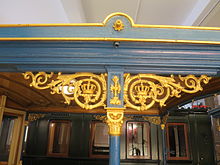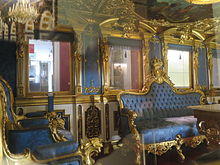Salon car of King Ludwig II of Bavaria
| Saloon car | |
|---|---|
| Number: | 1 |
| Manufacturer: | Klett & Comp. |
| Year of construction (s): | 1860 |
| Retirement: | 1918 |
| Axis formula : | 2 + 2 |
| Genre : | (WS) |
| Gauge : | 1435 mm ( standard gauge ) |
| Length over buffers: | 14,024 mm |
| Service mass: | 25,450 kg |
| Brake: | Westinghouse air brake |
| Train heating: | steam |
| Seats: | 3 compartments, 8 seats, 2 couches |
The saloon car of King Ludwig II of Bavaria is a saloon car from the court train of King Ludwig II of Bavaria . Today it belongs to the holdings of the Nuremberg Transport Museum .
prehistory
From 1858, King Maximilian II had his second court train built. This also included a saloon car for personal use by the king, Klett & Comp. made from Nuremberg . The frame of the vehicle is made of iron, the structure mainly of wood.
King Ludwig II took over this wagon from his father's inventory and had it massively redesigned.
history
Manufacturing
The conversion of the saloon car was one of the first "building activities" that the king was so happy to take on during his reign. First of all, Ludwig II had the approximately 50 centimeter high crown attached to the roof of the car in 1868, an exact copy of the Bavarian royal crown . This and the following conversion of the car were (also) a political demonstration: After the lost war of 1866 and the threatened mediatization of the Kingdom of Bavaria in a German Empire , which did not take place until 1871, Ludwig II rebelled against the progressive loss of power of his kingship .
Also in 1868, he gave the order to completely revise the design and equipment of the car in the Louis quatorze style . The absolutist King Louis XIV of France, builder of the Palace of Versailles , after which this style is named, was the great model for Ludwig II of Bavaria. A first draft was made by the architect Friedrich Bürklein . This first draft was not "Louis quatorze" enough for the king. He requested a revision, which was carried out by the technical director of the Munich court theater, Franz von Seitz , who was also involved in other building projects of the king at the time, including the design of the king's living quarters in the Munich residence and Linderhof palace . The conversion work on the saloon car took place in 1870. The saloon car looks like a theater backdrop and has become a "Versailles on wheels". The cost of converting the wagon was 19,000 guilders ; 7,104 guilders were accounted for by the gilding alone.
To decorate the then technically highly modern car in a style historically associated with absolutism was a contradiction in terms - and also a political announcement that was anachronistic in the middle-class environment of the 19th century. The very fact that a wagon used by a monarchical head of state was magnificently decorated and equipped, on the other hand, is not uncommon for the mid-19th century. With such vehicles, the protocol-based distance from the head of state was maintained even in the rail traffic, which is accessible to all and therefore relatively “ democratic ” .
Use by Ludwig II.
Ludwig II rarely used the car. During the only tour of the kingdom carried out by Ludwig II after the lost war from November 10 to December 10, 1866 to strengthen the loyalty of the Franks , the saloon car was part of the court train that was used for the journey, but was still in the simpler state of affairs that Ludwig II had taken over from his father. There is little evidence of its use for the time after the renovation in 1870.
On November 4, 1870, the king made a test drive with the now converted saloon car. On August 10, 1871, Ludwig II and the "new" Kaiser Wilhelm I met in Schwandorf . The emperor was on a trip to Bad Gastein . In Schwandorf he boarded Ludwig II's waiting train there, and both monarchs drove together to Regensburg . A contemporary witness noticed that the emperor drove into Schwandorf on a "brownish blackened, simple train" and switched to the "noble royal train" of the Bavarian king.
Ludwig II increasingly withdrew from the public eye and hardly ever used the eye-catching vehicle, which was already so visually public that he was afraid of. In the absence of documents on the use of the vehicle, it remains open whether and how often the king was out in his saloon car. For his few journeys, as the reign progressed, he increasingly preferred a special train made up of public transport passenger cars , not the court train cars, which were already very conspicuous in their external design, in order to travel “ incognito ”.
Use after the death of Ludwig II.
There are also only a few sources about the use of the vehicle after the death of King Ludwig II in 1886. His work on the court train for the Shah of Persia who is visiting Europe is certain . However, the car was technically modernized again from 1891–1893 by MAN in Nuremberg (formerly Klett & Comp. ) And was still in the car fleet of the Royal Bavarian State Railways in 1913 .
After the end of the Bavarian monarchy in 1918, the car was handed over to the Nuremberg Transport Museum by the Royal Bavarian State Railways by order of the Bavarian State Ministry for Transport , which was also under this ministry at the time. Since the Transport Museum moved into the Lessing building in 1925, the car has been on public display. During the Second World War , the vehicle was only insignificantly damaged in air raids , which also hit the museum, but was significantly damaged by looting immediately after the war . The parts that were removed were added in 1953, which was successful in terms of monument conservation because the original building and equipment plans were preserved. With this restoration, however, most of the signs of use were lost, so that the vehicle looks more “brand new” today.
description
Outside
The basic color of the saloon car is royal blue . On top are plastic , gold-plated decorations made of wood and bronze , strips, garlands , figurative decorations and heraldic elements. The approximately 50 centimeter high royal crown is located on the roof. The lush flower garlands over the windows and the putti are typical of the chosen Louis-quatorze style. Stylized lilies , arms plant of the French royal family, refer to Louis XIV Under the windows, in the center of the car, the royal coat of arms was placed, of which the right and left panels that. Monogram of the king in a wreath of oak - and laurel leaves.
Inside
The room layout is typical of a saloon car of this time: there are open entry platforms at both ends, from which central wing doors lead into the interior of the car. The doors between the rooms inside are then single-leaf and all lie in the central axis of the vehicle. The sequence of rooms:
- a small, two-seater compartment for company or servants, two small window axes
- the main saloon, which takes up about half of the interior of the car, has four window axes
- the sleeping compartment with two couches, one on the left and one on the right of the corridor, two window axes
- two small compartments opposite a central aisle with the toilet and a washroom for the king, two small window axes
The interior is decorated in the same style, but more splendid than the exterior. Here, too, gold-plated putti and garlands dominate. The ceiling is decorated with paintings, of which only the central one is still an original. The small pictures were stolen in the post-war period and replaced by copies in 1953. The originals were made by the theater painter Rudolf von Seitz , son of the aforementioned Franz von Seitz. Are shown allegorical motifs: In the central painting of the great salons embody four groups of figures that show children who four at the time of Louis XIV known. Continents . In the center of the painting is the ceiling lighting, which also symbolizes the sun . The central painting is surrounded by four smaller paintings in which pairs of putti represent one of the four seasons. In the bedroom, day and night are each depicted in a ceiling painting.
King Ludwig II's saloon car is considered to be the most splendidly equipped in Germany.
technology
The equipment with toilet and washroom was state-of-the-art for the time, but also quite common in a saloon car. In 1870 the car also received steam heating and kerosene lighting . In 1893 gas lighting and a Westinghouse air brake were installed.
See also
literature
- Ursula Bartelsheim: Versailles on Wheels - Ludwig II and his court train (object stories from the DB Museum 1). Nuremberg 2009, ISBN 978-3-9807652-5-1 .
- Sabine Fritsche: Ludwig II's court saloon car. History of construction and planning . Unpublished master's thesis. Regensburg 1984.
Remarks
- ↑ It is not known whether this name was already used during the time of Ludwig II. (Bartelsheim, p. 14.)
- ↑ For comparison: The entire planning of the Fürth – Rottendorf railway line in 1860 cost 17,000 guilders (Rolf Syrigos, Horst Wendler: Gone the terrible time . In: EisenbahnGeschichte 70 (2015), pp. 4–16 [5]).
- ↑ Napoleon III. had a court train in neo-Gothic style, "Train Impérial", which could be seen at the World Exhibition in Paris in 1867, where Ludwig II probably saw it (Bartelsheim, p. 17). Designs for splendid saloon cars have also been preserved for the Elector of Hesse and the King of Hanover (Bartelsheim, p. 18f).
- ↑ At that time the royal train of the Prussian king was painted a maroon color (see: here ).
- ↑ Bartelsheim's statement that it was supposed to have been a trip by Mozaffar ad-Din Shah in 1889 cannot be correct. Mozaffar ad-Din Shah did not rule until 1896.
Individual evidence
- ↑ Information from Bartelsheim, p. 43
- ↑ Bartelsheim, p. 7.
- ↑ a b Bartelsheim, p. 43.
- ↑ Bartelsheim, p. 8.
- ↑ Bartelsheim, p. 22f.
- ↑ Bartelsheim, p. 18.
- ↑ a b Bartelsheim, p. 14.
- ↑ a b Bartelsheim, p. 21.
- ↑ Bartelsheim, pp. 21, 31.
- ↑ Bartelsheim, p. 41.
- ↑ a b Bartelsheim, p. 25.
- ↑ Bartelsheim, p. 15.
- ↑ Bartelsheim, pp. 19, 35.
- ↑ Bartelsheim, p. 35f.
- ↑ Bartelsheim, p. 45.
- ↑ Bartelsheim, p. 46.
- ↑ a b Quoted from Bartelsheim, p. 37.
- ↑ Bartelsheim, p. 33.
- ↑ a b Bartelsheim, p. 39.
- ↑ Bartelsheim, p. 10f.
- ↑ a b Bartelsheim, p. 5.
- ↑ Bartelsheim, pp. 5, 43.
- ↑ Bartelsheim, p. 22.
- ↑ Bartelsheim, pp. 26, 41.
- ↑ Bartelsheim, pp. 26, 29.
- ↑ Bartelsheim, p. 28.
- ↑ Bartelsheim, p. 26.
- ↑ Bartelsheim, pp. 25, 43.




